British Keys
Many of the early British telegraph instruments operated on what is called a Double Current Telegraph System.
The US and most of the world used a Single Current system, where current flows only in one direction. A dot or dash is caused by current flowing through the relay, while a space is caused by the absence of a current.
However, in a Double Current system, current flows in one direction through the relays to produce dots and dashes, and flows in the opposite direction to produce spaces. This is accomplished through the use of a Polarized Relay.
Double Current systems are more efficient and can handle higher data rates because the action of changing polarity on the line neutralizes the residual charge on the line when the key is opened. With Single Current systems, this residual charge takes time to dissipate, which limits how fast data can be sent.
Below are some pictures of some interesting keys from Great Britain, including single & double current keys as well as radio keys. Many are stamped "GPO", which stand for General Post Office.
*NOTE: For pictures of British spark keys such as Marconi, please visit my Spark Keys Page.
(Click on each thumbnail to view the full size image):
 |
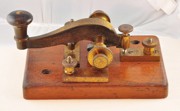 |
 |
 |
| Early British Camelback Key Marked GPO 187 | Another View of the Camelback Key | GPO Number Stamp | Another Early British Camelback Key of Similar Design to the GPO 187 Key (sciencemuseum group.org.uk) |
 |
 |
 |
 |
| Another View of the Early British Camelback Key | Stroh Double-Current Key, Patented 1868 | Top View of the Stroh Key. The Lever Pivots Sideways to Change Between Send & Receive | 6-Terminal Double Current Reversing Key by Warden & Co. (Varley Patent of 1858) Westminster, England |
 |
 |
 |
 |
| Another Varley Patent Key | Postal Key Made By Siemens Brothers & Co. Ca. 1880 | Another View of the Siemens Brothers Key Showing the Name | Classic Style Double Current Key With Glass Cover |
 |
 |
 |
 |
| Double Current Key With Cover Removed | Another Double Current Key by H. White, 1917 | White Key With Cover Removed | Early Double Current Key. GPO Type 33 |
 |
 |
 |
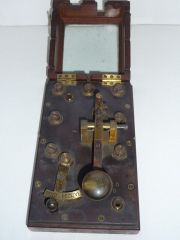 |
| Another View of the GPO Type 33 Key | The Underside of the GPO Type 33 Key | GPO 160 Double Current Key With Glass Cover | The GPO 160 Key With the Cover Lifted |
 |
 |
 |
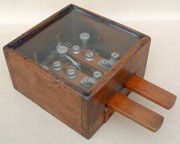 |
| The Underside of the GPO 160 Key | Early Double Current Key GPO Type 866 | Walters Electrical Type 6K Double Paddle Key. Used for Double Current & Cable Telegraph | Double Paddle Key With Glass Cover in Place |
 |
 |
 |
 |
| Another Early Double Current Key Without the Glass Cover. Gent & Co. Ltd. | Another View of the Gent & Co. Double Current Key | GPO Type 562 | British Railway Block Bell & Key. Used for Sending Signals Between Switch Towers. These Sets were NOT used to Send Morse Code |
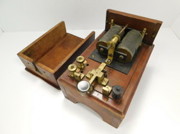 |
 |
 |
 |
| Inside the Block Bell Instrument. These Instruments Were Used to Send Codes to Indicate the Status of Trains Occupying Different Sections of Track | Close-Up of the Signalling Bell. For More Information About Block Bell Instruments, Check Out My Page on Needle Telegraph & Block Signalling | GPO Type 2036 | GPO Type 3092 |
 |
 |
 |
 |
| Single Current Key by Elliott Brother, London | Another View of the Elliott Brothers Key | Practice Key by GH Steward, 1898 | Another British Practice Key |
 |
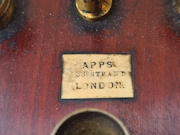 |
 |
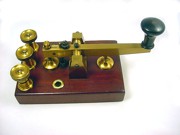 |
| Early British Key Made by Alfred Apps, London. Ca. 1900 | Close-Up of the Apps Nameplate | Postal Key by Elliott Brothers | Another Postal Key, Maker Unknown |
 |
 |
 |
 |
| A GPO "PATT 1056A" Postal Style Key (Pattern 1056A) | Another View of the PATT 1056A GPO Postal Key | Another PATT 1056A Key. This One is Made by Baird & Tatlock | Close-Up of the Baird & Tatlock Emblem |
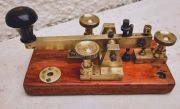 |
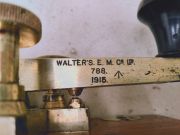 |
 |
 |
| A Third PATT 1056A Key by Walters Electrical | Close-Up of the Name Stamp on the Walters Key | Another Key by Baird & Tatlock | Unknown Postal Style Key, Possibly British |
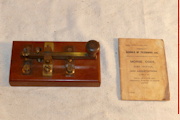 |
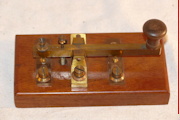 |
 |
 |
| Admiralty Telegraph School Training Key | Another View of the Admiralty Training Key | Postal Style Key by AH Baird, Edinburgh Scotland. Ca. 1910 | Close-Up of the AH Baird Name Stamp |
 |
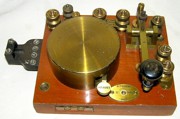 |
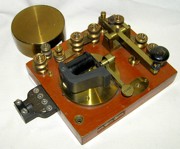 |
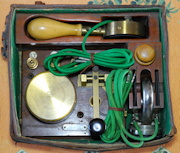 |
| Possibly British Key Marked "Marshall Key". Maker Unknown | Ediswan Key & Buzzer Set | Ediswan Set With Buzzer Cover Removed | A Key & Buzzer Set by Walters Electrical, London. 1917 |
 |
 |
 |
 |
| The Key & Buzzer Set Includes a French Made Microphone and Earpiece so the Set Can be Used Like a Telephone | The Walters Key & Buzzer Set With the Cover Removed to Show the Buzzer | Radio Key by A. Mason, Surrey England | Walters Electrical Model 18K Postal Key With Leaf Spring Pivot |
 |
 |
 |
 |
| Different Style Walters 18K With Send-Receive Switch | Another Walters Key | Different View of the Walters Key | 2 Walters Electrical Keys |
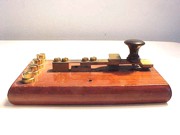 |
 |
 |
 |
| Walters Electrical Model 20K | Postal Style Key with Switch. Marked P.L. 7019 | Close-Up of the Circuit Closer Switch on the P.L. 7019 Key | Postal Style Key by Charles Palmer |
 |
 |
 |
 |
| Close-up of the Palmer Name | Another Key by Charles Palmer | A Railroad Signal Block Key. Not Used for Sending Morse (See Page on British Needle Telegraph for More on Block Signalling) | Close-Up of the Railroad Signal Block Key |
 |
 |
 |
 |
| Another British Railroad Signal Block Key | Another View of the Signal Block Key | A Third Railroad Signal Block Key | Morse Training Key by WG Pye & Co, Cambridge |
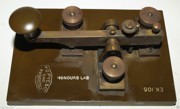 |
 |
 |
 |
| Top View of the Pye Key | A Small Dummy Telegraph Key Used for Practicing Morse. The Operator Would Learn the Code by Listening to the Clicking Sounds. There Are No Electrical Connections | Close-Up of the Name on the Dummy Key. Made by William McGeoch & Co, Glasgow Scotland, 1916 | The Victory Key. Used for Code Practice. Post-WW1 |
 |
 |
 |
 |
| Close-up of the Victory Key | The Underside of the Victory Key Showing the Buzzer Mechanism | Unusual Split Lever Key Possibly Made by Siemens, a German Company | Another View of the Split Lever Key |
 |
 |
 |
 |
| Split Frame Key by ATM | Top View of the ATM Key | A Miniature All Brass Key From the UK. Maker Unknown | Side View of the Miniature Brass Key |
 |
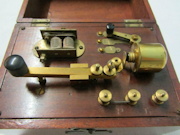 |
 |
 |
| A Key, Buzzer, and Light Set by Lowdon Scientific Instrument Co. | Close-Up of the Lowdon Instrument Co. Components | Close-Up of the Lowdon Nameplate | Another Key-Light Signalling Set. Maker Unknown |
 |
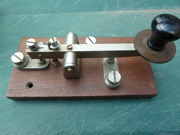 |
 |
 |
| Walters Electrical Postal Key With Slot for Bug Wedge | Another Postal Style Key by Walters Electrical | Close-Up of the Walters Nameplate | A Third Postal Style Key by Walters Electrical |
 |
 |
 |
 |
| Postal Style Key by Ward & Goldstone | Close-Up of the Ward & Goldstone Nameplate | Postal Style Key by Gamage | Close-Up of the Gamage Name Stamp |
 |
 |
 |
 |
| British Postal Style Key With and Unusual Pivot Frame | Another View of the Unusual Pivot | RAF Airplane Key With Winker Lamp (F9WT Collection) | Postal Key by Pye & Co. |
 |
 |
 |
 |
| Another Pye & Co Key | Postal Style Key by Signalling Equipment Ltd. Ca. 1940's | Unknown Key, Possibly for Wireless Use | Marconi Type PS-213a With Cover |
 |
 |
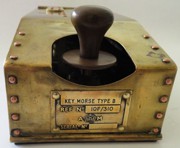 |
 |
| Air Ministries RAF Type B Aircraft Key | Inside the Type B Key | Type B Key Nameplate | RAF Type D Key used at ground stations (F9WT Collection) |
 |
 |
 |
 |
| Inside the Type D Key | Flameproof Key With Air Ministries Marking | Inside the Air Ministries Key | Key From Fullerphone MKIII Field Telegraph Set |
 |
 |
 |
 |
| A Different Version of the Fullerphone MKIII Key With a Longer Lever | Key From Fullerphone MKV Field Telegraph Set (F9WT Collection) | British "Bathtub" Key Used on the Lancaster Bomber | Inside the Bathtub Key. The Metal Clip, in Addition to Holding the Cover in Place, Could be Moved Forward Over the Key Knob to Keep the Key in Constant Transmit in Case of Emergency Landing |
 |
 |
 |
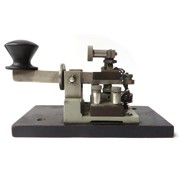 |
| Small British Key with Large Contacts. Maker Unknown | Top View of the Small British Key | Unknown Small Key Possibly Part of a Field Transmitter Set | Another Similar Field Set Key |
 |
 |
 |
 |
| WW2 Admiralty Key & Buzzer Code Practice Set With the Original Battery Intact | Top View of the Admiralty Code Practice Set | Admiralty Pattern Type 2342 | Admiralty Pattern Type 691 |
 |
 |
 |
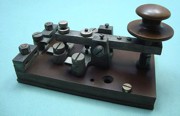 |
| Admiralty Type 691 With Cover Removed | Admiralty Pattern Type 5475 | Admiralty Pattern Type 65485 | Admiralty Pattern Type 7681 (F9WT Collection) |
 |
 |
 |
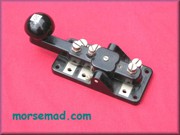 |
| Close-up of the Type 7681 Name | The Admiralty Pattern Type 7681 With Optional Cover | British Military WT-8Amp Key | Another Style of the WT-8Amp |
 |
 |
 |
 |
| A WT-8Amp Key Made by JH Bunnell, NY | Another WT-8Amp Key. This One Was Made by the Canadian Company, Westclox | Unknown British Key. Has Some Similarities to a WT-8Amp | A Side View of the Uknonwn British Key |
 |
 |
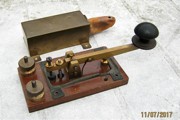 |
 |
| British Spitfire Fighter Plane Landing Light Key | British Aircraft Flameproof Key. Has a Gasket Around the Lever to Make it Flameproof. Made by Lucas Ltd. in Birmingham England | Inside the Flameproof Key | Another British Flameproof Aircraft Key. Maker Unknown |
 |
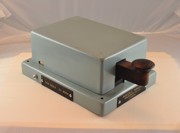 |
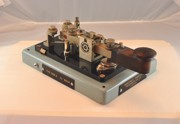 |
 |
| Another View of the Flameproof Key With the Cover Removed | Marconi Wireless Type 365A | Inside the Marconi 365A | Signalling Equipment Ltd. Key |
 |
 |
 |
 |
| Close-up of Label | Signalling Equipment Key Used in Double Current Configuration | Unknown Possible Signalling Key | Top View of the Unknown Light Signalling Key |
 |
 |
 |
 |
| Practice Key by The Dulci Co. London | Another View of the Dulci Key | Miniature Key Used in British SOE Type B2 Spy Set | Close-Up of the SOE Spy Key |
 |
 |
 |
 |
| BCE Model 502 Miniature Waterproof Lifeboat Transmitter Key. It was Attached to a Leather Strap to Hold it to the Operator's Leg | Another Lifeboat Transmitter Key of Same Size & Design Made by McMurdo Co. | The Lifeboat Transmitter Key With a Quarter for Size Comparison | This Lifeboat Transmitter Key Was Made in Australia by AWA (Amalgamated Wireless Australia). 1962 |
 |
 |
 |
 |
| Top View of the Key Showing the AWA Name and Model | Unknown Key Possibly Used in Shipboard Wireless | Another View of the Shipboard Key | Walters Model 5KK Mounted on Tuner Box |
 |
 |
 |
 |
| The Walters 5KK With Cover Removed | Marconi Type 316A (F9WT Collection) | 316A Key With Cover Removed | Marconi Type 971 |
 |
 |
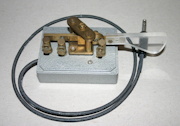 |
 |
| Inside the Type 971 Key | Marconi Marine Type 1588. Used With Marconi AD107 Transmitter | A Sideswiper Style Key Made by Marconi Wireless for the British Diplomatic Services | Unknown Key Stamped GB-1091 |
 |
 |
 |
 |
| Marconi Marine 365-FZ | Inside the Marconi Marine 365-FZ | The Marconi 365-FZ Label | Marconi Marine Key Used With Salvor Emergency Lifeboat Transmitter |
 |
 |
 |
 |
| Side View of the Salvor Key | Key Used by the British SAS (Special Air Service) | The British SAS Key With the Cover Removed | Unknown British Key in Metal Box. Possibly Made by Marconi Wireless or Marconi Marine |
 |
 |
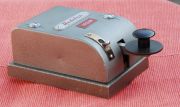 |
 |
| The Same Key With the Metal Cover Removed | Unknown Key With a Send/Receive Switch. Possibly Made by Marconi Wireless | Marconi 365-Style Key by Redifon | The Redifon Key With the Cover Removed |
 |
 |
 |
 |
| Another Marconi 365-Style Key | Another View of the Marconi 365-Style Key | Ivalek Standard Morse Key. Ca. 1950 | Close-Up of the Ivalek Name |
 |
 |
 |
 |
| Key Used by NATO Forces | Inside the NATO Key | Marconi Marine Z-50 | Marconi Marine Z-50 With Cover Removed |
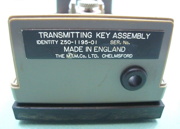 |
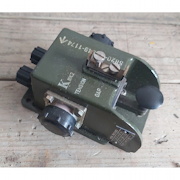 |
 |
 |
| Close-Up of the Z-50 Nameplate | Key from British Larkspur Tactical Radio Set. Ca. 1950's | Another View of the British Larkspur Key | ITT Marine Key |
 |
 |
 |
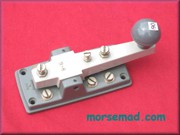 |
| Inside the ITT Marine Key | Small British Military Key With Leg Strap. Used With the Racal PRC-320 HF Radio | Close-Up of the Key | SR-Cotel Radio Key by Jack Sykes, G3SRK |
 |
|||
| Key From Clansman Wireless Set. Ca. 1980 |
Questions or comments?
You can reach me at telegraphdude@comcast.net
